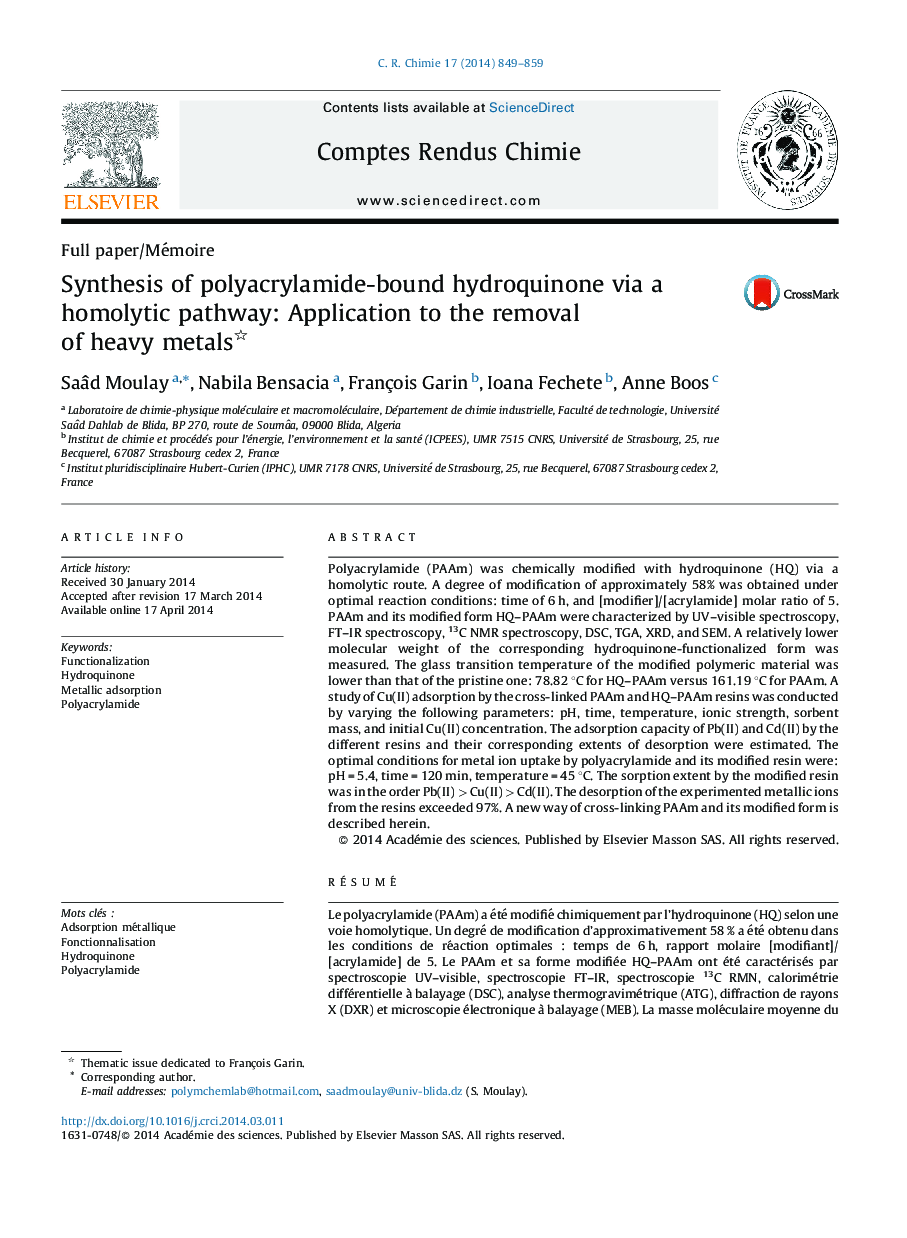| کد مقاله | کد نشریه | سال انتشار | مقاله انگلیسی | نسخه تمام متن |
|---|---|---|---|---|
| 170534 | 458398 | 2014 | 11 صفحه PDF | دانلود رایگان |
Polyacrylamide (PAAm) was chemically modified with hydroquinone (HQ) via a homolytic route. A degree of modification of approximately 58% was obtained under optimal reaction conditions: time of 6 h, and [modifier]/[acrylamide] molar ratio of 5. PAAm and its modified form HQ–PAAm were characterized by UV–visible spectroscopy, FT–IR spectroscopy, 13C NMR spectroscopy, DSC, TGA, XRD, and SEM. A relatively lower molecular weight of the corresponding hydroquinone-functionalized form was measured. The glass transition temperature of the modified polymeric material was lower than that of the pristine one: 78.82 °C for HQ–PAAm versus 161.19 °C for PAAm. A study of Cu(II) adsorption by the cross-linked PAAm and HQ–PAAm resins was conducted by varying the following parameters: pH, time, temperature, ionic strength, sorbent mass, and initial Cu(II) concentration. The adsorption capacity of Pb(II) and Cd(II) by the different resins and their corresponding extents of desorption were estimated. The optimal conditions for metal ion uptake by polyacrylamide and its modified resin were: pH = 5.4, time = 120 min, temperature = 45 °C. The sorption extent by the modified resin was in the order Pb(II) > Cu(II) > Cd(II). The desorption of the experimented metallic ions from the resins exceeded 97%. A new way of cross-linking PAAm and its modified form is described herein.
RésuméLe polyacrylamide (PAAm) a été modifié chimiquement par l’hydroquinone (HQ) selon une voie homolytique. Un degré de modification d’approximativement 58 % a été obtenu dans les conditions de réaction optimales : temps de 6 h, rapport molaire [modifiant]/[acrylamide] de 5. Le PAAm et sa forme modifiée HQ–PAAm ont été caractérisés par spectroscopie UV–visible, spectroscopie FT–IR, spectroscopie 13C RMN, calorimétrie différentielle à balayage (DSC), analyse thermogravimétrique (ATG), diffraction de rayons X (DXR) et microscopie électronique à balayage (MEB). La masse moléculaire moyenne du HQ–PAAm était relativement basse. La température de transition vitreuse du PAAm modifié était plus basse que celle du PAAm : 78,82 °C pour HQ–PAAm, contre 161,19 °C pour le PAAm. Une étude de l’adsorption du Cu(II) par les résines à base de PAAm et de HQ–PAAm réticulés a été menée en faisant varier les paramètres suivants : pH, temps, température, force ionique, masse du sorbant et concentration initiale en Cu(II). Les capacités d’adsorption de Pb(II) et Cd(II) par les résines et les taux de leur désorption ont été estimées. Le taux d’adsorption par la résine modifiée variait dans l’ordre Pb(II) > Cu(II) > Cd(II). La désorption des ions métalliques dépassait 97 %. Une nouvelle voie de réticulation de PAAm et sa forme modifiée est décrite.
Journal: Comptes Rendus Chimie - Volume 17, Issues 7–8, July–August 2014, Pages 849–859
